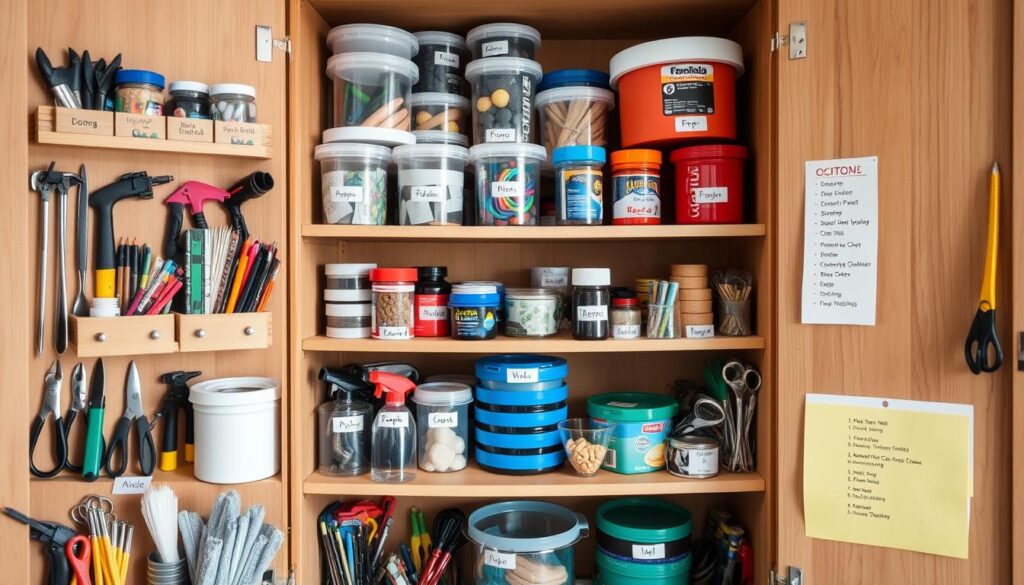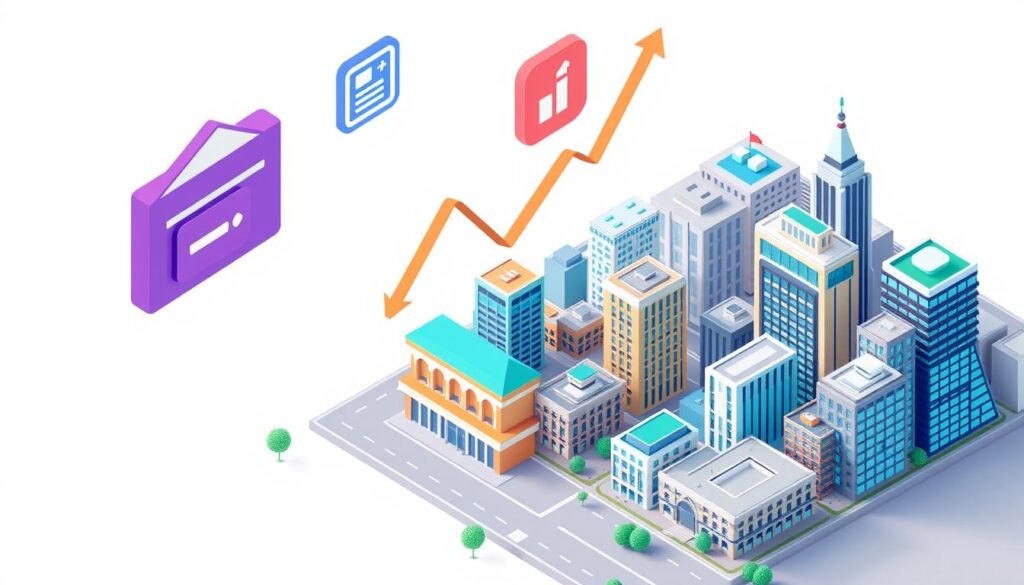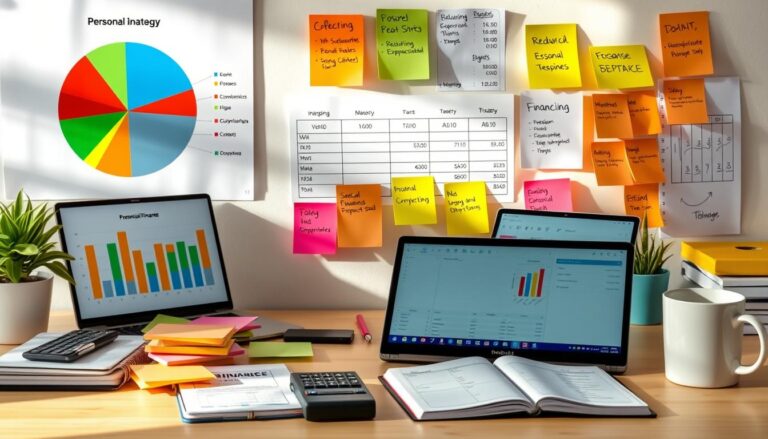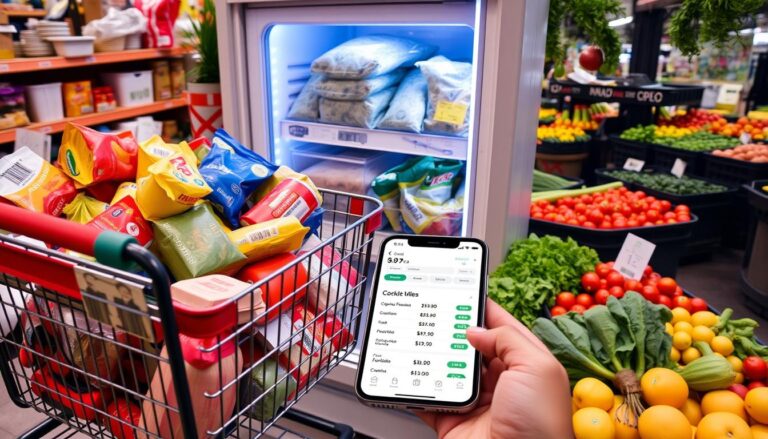10 Creative Saving Money Hacks for Everyday Expenses
Learning about personal finance doesn’t need a degree. With smart saving tips, you can change your money situation a lot. Making small changes in how you spend can lead to big savings, making it easy for anyone to live frugally.
Think about cutting down on daily costs without losing out on quality. Using cash-back cards, budget apps, and smart shopping can save you money. By using creative money management, you’ll find it fun and rewarding.
Table of Contents
The Power of Smart Financial Planning
Financial planning is your roadmap to financial freedom. With 60% of Americans struggling to cover a $1,000 emergency expense, managing your money is key. Smart financial planning turns financial chaos into strategic control.
Setting clear, achievable goals is the first step in successful financial planning. Statistics show that those with a detailed savings plan save more. Your financial journey needs vision, discipline, and practical budgeting tips.
Setting Clear Financial Goals
Creating meaningful financial goals requires a strategic approach. Here are key steps for effective goal setting:
- Define specific, measurable objectives
- Break larger goals into monthly milestones
- Use the SMART goals framework
- Track progress consistently
Creating a Realistic Budget Framework
The 50/30/20 budgeting rule is a practical framework for financial planning:
- 50% for necessities (rent, utilities, groceries)
- 30% for discretionary spending
- 20% for savings and debt repayment
“A goal without a plan is just a wish.” – Financial Planning Wisdom
Tracking Monthly Expenses
Cutting expenses starts with understanding your spending patterns. Use budgeting apps or spreadsheets to monitor your financial habits. Research shows that tracking expenses helps stick to savings goals by 27%.
By using these financial planning strategies, you’ll change how you manage money. You’ll build a stronger financial future.
Automating Your Savings Strategy
Smart spending begins with automating your savings. This makes saving money easy and automatic. By setting up automatic transfers, you can grow your wealth without much effort.
“Automation turns saving from a choice into a default behavior” – Financial Expert
Here are key strategies for effective savings automation:
- Direct deposit splitting: Allocate 20% of your paycheck directly to savings
- Round-up savings programs: Automatically save small amounts from daily purchases
- Goal-based savings “buckets” to track multiple financial objectives
Digital tools make saving money easy. Many banks and apps offer features for automated savings. They can:
- Transfer fixed amounts weekly or monthly
- Round up purchases and save the difference
- Create separate savings accounts for specific goals
| Savings Method | Weekly Investment | Annual Potential |
|---|---|---|
| App-based Savings | $25 | $1,300 |
| Round-up Savings | $5-$10 | $260-$520 |
Pro tip: Choose automation strategies that align with your personal finance goals and lifestyle. The key is consistency and making saving money feel seamless and natural.
Mastering the Art of Saving Money
Saving money is more than just putting cash aside. It’s a smart way to manage your finances. You need skill, dedication, and good planning to start.
Experts say to save at least 20% of your income. This can really boost your financial health. It sets a strong base for your future.
High-Yield Savings Accounts: Your Financial Accelerator
High-yield savings accounts offer better returns than regular ones. They can change your investment game. These accounts give you:
- Higher interest rates
- Fast money growth with compound interest
- A low-risk way to grow your money
Building a Rock-Solid Emergency Fund
Having an emergency fund is key to financial planning. Try to save:
- 3-6 months of living costs
- Money in easy-to-reach accounts
- Protection from sudden money problems
“The best investment advice is to prepare for the unexpected while planning for the future.”
Exploring Investment Opportunities
Diversifying your investments can cut down risk by 40%. Look into:
- Index funds with low fees
- Exchange-traded funds (ETFs)
- Retirement accounts like 401(k) and IRA
Remember, saving regularly and investing wisely are crucial for long-term success.
Smart Shopping and Loyalty Programs
Saving money doesn’t mean you have to give up quality. Smart spending is about using strategies that help you stretch your budget. Experts say using loyalty programs and cashback can make shopping more rewarding.
“Every dollar saved is a dollar earned” – Wise Shopping Principle
Retailers offer many ways to save money. Here are some smart shopping tips:
- Join loyalty programs at stores you visit often
- Use cashback credit cards for daily buys
- Compare prices on different platforms
- Keep an eye out for seasonal sales
- Use tools to track prices
Online shoppers can save up to 20% by comparing prices. Cashback programs can save 1% to 5% on what you buy. Timing is key – waiting for big sales like Black Friday can lead to big discounts.
Loyalty programs offer more than just immediate savings. They give:
- Special member discounts
- Points that add up over time
- Early access to sales
- Personalized shopping experiences
Pro tip: Always think about the cost-per-use of items. Spending a bit more on quality items might save you money in the long run by needing to replace them less often.
Innovative Ways to Cut Monthly Bills
Cutting expenses doesn’t have to be hard. Smart budgeting tips can lower your monthly bills a lot. You can save money and feel better about your finances by making smart choices.
Bundle Services for Maximum Savings
Service bundling is a smart way to save money. By getting internet, cable, and phone together, you might save $40 per month. Many providers offer deals that make your bills lower.
- Negotiate with current service providers
- Compare bundle packages across different companies
- Review contract terms carefully
Energy-Efficient Solutions
Using less energy can really cut down on utility bills. Here are some easy ways to save:
- Install smart thermostats
- Use LED light bulbs
- Choose energy-star appliances
- Reduce water consumption
“Small changes in energy consumption can lead to substantial savings over time.” – Financial Experts
Subscription Management Tips
In January 2024, almost 99% of U.S. homes had a streaming service. But, too many subscriptions can cost too much. Check your subscriptions often to save money.
- Review all current subscriptions monthly
- Cancel unused services
- Look for more affordable alternatives
- Share accounts when possible
By using these smart strategies, you can cut down on monthly costs. This will help you feel better about your finances.
DIY Solutions for Everyday Savings

Frugal living is not about giving up quality. It’s about using smart money-saving strategies. DIY projects are a great way to save money and learn new skills.
“Learning to do things yourself is the ultimate financial empowerment.” – Financial Expert
Doing things yourself can really lower your household costs. Professional services can be pricey. But, with online tutorials and a bit of patience, you can handle many tasks on your own.
- Basic home repairs
- Car maintenance
- Home cleaning
- Simple appliance fixes
- Clothing alterations
Learning DIY skills from free online resources like YouTube can save you a lot. Experts say DIY projects can cut service costs by up to 70%.
| DIY Task | Average Professional Cost | Estimated DIY Savings |
|---|---|---|
| Painting a Room | $500 | $350 |
| Basic Plumbing Repair | $250 | $200 |
| Car Oil Change | $75 | $45 |
Start small and build your DIY skills gradually. Not all tasks are right for DIY—know your limits and keep safety first.
By choosing DIY solutions, you’ll save money and feel more confident in managing your finances and skills.
Transportation Cost-Cutting Strategies
Transportation costs can quickly add up. But, there are smart ways to save money. By taking care of your vehicle, trying out different ways to get around, and using fuel wisely, you can cut down on costs.
Smart spending on transportation means knowing how to take care of your vehicle and finding cheaper ways to travel. Budgeting tips can help you save money without giving up your freedom to move around.
Vehicle Maintenance Tips
Regular maintenance is key to saving money. Here are some important tips:
- Do routine oil changes every 5,000-7,500 miles
- Check tire pressure monthly to improve fuel efficiency
- Replace air filters regularly to optimize engine performance
- Fix minor repairs quickly to avoid expensive breakdowns
“Preventive maintenance can reduce vehicle downtime by 30-40%, leading to significant long-term savings.” – Transportation Cost Experts
Alternative Transportation Options
Using less of your personal vehicle can save a lot of money. Here are some ways to save:
- Carpool with coworkers or neighbors
- Use public transportation
- Bike for short trips
- Work from home when you can
Fuel Efficiency Techniques
Fuel costs can be a big part of your budget. Here are ways to save:
- Drive at steady speeds on highways
- Remove extra weight from your vehicle
- Use cruise control on long drives
- Think about getting a fuel-efficient or electric vehicle
By using these tips, you can save money, help the environment, and make better financial choices.
Maximizing Grocery Shopping Savings
Saving money on groceries needs smart planning and strategic shopping. Over the last four years, grocery prices have gone up by 22.5%. Using frugal living tips can cut down your monthly costs a lot. Your grocery budget is a key area where smart spending can really help.
“Strategic grocery shopping can save you hundreds of dollars annually without compromising nutrition.”
Here are some proven ways to save on your grocery bills:
- Create a detailed meal plan before shopping
- Use cash-back apps like Ibotta and Rakuten
- Compare unit prices carefully
- Buy generic brands
- Shop seasonal produce
Knowing how you spend on groceries helps you budget better. The average American household spends $475.25 a month on groceries. But, you can cut this cost with smart strategies.
| Strategy | Potential Savings |
|---|---|
| Using Generic Brands | 20-25% off name brands |
| Seasonal Produce Shopping | Up to 50% reduction |
| Bulk Purchasing | 25% savings on per-unit costs |
| Loyalty Program Usage | 5-20% additional savings |
By using these saving money tips, you can lower your grocery costs and still eat well. Remember, smart spending is about making informed choices, not just cutting costs.
Smart Banking and Credit Card Hacks

Managing your personal finance needs smart thinking about banking and credit cards. Smart money management can lead to big savings. Many people miss out on these opportunities.
Knowing how to use your banking and credit cards wisely can change your saving game. Let’s dive into some effective strategies to boost your financial health.
Avoiding Bank Fees
Bank fees can quietly eat away at your money. Here are some tips to cut down on these costs:
- Choose fee-free checking accounts
- Maintain minimum balance requirements
- Use in-network ATMs
- Set up direct deposit to waive monthly maintenance fees
Cashback Rewards Optimization
Credit card rewards can be a big help in your financial planning. Here are some tips to get the most from cashback:
| Card Type | Average Cashback | Best For |
|---|---|---|
| Grocery Rewards Card | 3-6% | Frequent grocery shoppers |
| Travel Rewards Card | 2-5% | Regular travelers |
| Flat-Rate Cashback Card | 1.5-2% | Consistent everyday spending |
Credit Score Management
Your credit score is key to your financial health. Here’s how to protect and boost it:
- Pay all bills on time
- Keep credit utilization below 30%
- Monitor your credit report annually
- Avoid opening multiple credit lines at once
“Your credit score is your financial reputation. Treat it with respect.” – Financial Expert
By using these smart banking and credit card tips, you can save money, earn rewards, and build a solid financial base.
Creative Ways to Save on Entertainment
Enjoying entertainment doesn’t have to drain your wallet. You can have fun without spending a lot. Discovering new ways to enjoy yourself can save you money and keep your lifestyle exciting.
Local communities have many free or low-cost entertainment options. Here are some smart ways to save on fun activities:
- Explore free community events in your area
- Leverage public library resources
- Utilize city passes for discounted attractions
- Take advantage of online streaming platform deals
Your local library is full of entertainment. It’s not just for books. Many libraries offer:
- Free movie streaming services
- Educational courses
- Cultural event passes
- Music and digital media collections
“Entertainment doesn’t have to be expensive to be enjoyable.” – Budget-Conscious Traveler
It’s easy to save on entertainment. Hosting game nights at home can save you up to 60% compared to going out. Being creative can make a big difference in your budget.
Here are some tips to save on entertainment:
- Host potluck dinners instead of dining out
- Share streaming service accounts within households
- Look for group discounts on events
- Attend free local concerts and community gatherings
Using these strategies can make your entertainment budget-friendly. It’s not about cutting out fun. It’s about finding ways to enjoy yourself that are both creative and affordable.
Mindful Spending Techniques
Personal finance is more than just tracking money. It’s about how you relate to money. Smart spending means thinking deeply about your choices, not just following budget tips.
Learning to spend mindfully can change your financial life. Studies show making smart choices can cut down on waste and help you stay financially stable for good.
The 30-Day Purchase Rule
The 30-day rule helps stop you from buying on impulse. Here’s how it works:
- When you want to buy something you don’t need, wait 30 days
- Write down the item and its price
- After 30 days, check if you still want to buy it
This method can really cut down on impulse buys. Many people find they don’t want the item after waiting.
Expense Tracking Methods
| Tracking Method | Effectiveness | Ease of Use |
|---|---|---|
| Mobile Budgeting Apps | High | Easy |
| Spreadsheet Tracking | Medium | Moderate |
| Cash-Only System | High | Challenging |
Prioritizing Needs vs Wants
Knowing the difference between needs and wants is key in personal finance. Ask yourself: “Would I be financially stable without this purchase?” This simple question can help you avoid spending on things you don’t really need.
“Mindful spending is not about restricting yourself, but about making intentional choices that align with your financial goals.”
By using these strategies, you can spend more mindfully. This supports your financial health in the long run.
Conclusion
Saving money is more than just cutting costs. It’s a full plan for your finances that changes your future. The strategies we’ve talked about give you a clear path to better financial planning. This helps you stay strong and safe in uncertain times.
Did you know 61% of people over 50 worry about saving for retirement? By using the creative saving tips from this article, you can tackle these worries. Making small, steady changes in how you handle money can greatly boost your savings and ease financial stress.
Your path to saving money is your own. It might involve paying off credit card debt, finding high-yield savings accounts, or boosting your retirement savings. Every step counts. With the right mindset and a smart plan for your finances, you can build a more stable and prosperous future. Begin now, stay focused, and watch your financial dreams become a reality.
The power to secure your financial future is yours. By staying informed, making wise choices, and using these saving tips, you’ll create a stronger financial base for yourself and your loved ones.
FAQ
How much money should I aim to save each month?
What’s the best way to start an emergency fund?
How can I save money if I’m living paycheck to paycheck?
Are cashback credit cards really worth it?
How can I reduce my monthly bills?
What’s the 30-day purchase rule?
How can I save money on groceries?
What are some free ways to entertain myself?
How important is my credit score for saving money?
What’s the first step in creating a personal budget?
Source Links
- 12 Ways To Save Money Every Day | Bankrate – https://www.bankrate.com/banking/savings/how-to-save-money-every-day/
- 28 Proven Ways to Save Money – NerdWallet – https://www.nerdwallet.com/article/finance/how-to-save-money
- 23 Money Saving Hacks That Work – https://www.makingsenseofcents.com/2025/01/money-saving-hacks.html
- Save money in the new year by setting SMART financial goals – https://www.websterfirst.com/blog/smart-financial-goals/
- Money Moves: Smart Financial Strategies for Early Career Success – https://www.johnsonfinancialgroup.com/resources/your-money-your-mission/money-moves-smart-financial-strategies-for-early-career-success/
- How to automate your savings: 5 simple tips – https://www.lendingclub.com/resource-center/personal-finance/simple-steps-on-how-to-start-saving-money
- 4 reasons automating your savings makes it easier to build wealth – https://www.businessinsider.com/reasons-automating-savings-easier-build-wealth-2024-7
- Mastering the Art of Saving: A Roadmap to Financial Freedom – https://www.finideas.com/mastering-the-art-of-saving-a-roadmap-to-financial-freedom/
- 14 Ways to Save More Money in 2025 – https://www.quicken.com/blog/14-best-ways-to-save-money/
- How Shopping Smarter Can Stretch Your Dollars – https://www.commbank.com.au/brighter/magazine/how-shopping-smarter-make-your-money-go-further.html
- Albert | How to Meet Your Budget When Shopping for Essential Items – https://albert.com/blog/what-can-help-you-meet-your-budget-while-shopping-for-important-items
- Smart Shopping Tips for Budget-Conscious Consumers – https://lexiconbank.com/blog/tips-for-budget-smart-shopping/
- 16 Ways to Cut Costs: Strategies for Reducing Expenses – https://www.debt.org/advice/how-to-cut-expenses/
- How to Cut Spending – https://www.ramseysolutions.com/saving/how-to-cut-costs?srsltid=AfmBOoo-jAEoXFSKRF43L-_80DkYUwkF2_o4LlAoyYC2xfuLquPxJqaT
- How to Save Money: 23 Ways to Start Today – https://www.ramseysolutions.com/budgeting/the-secret-to-saving-money?srsltid=AfmBOorBrq-7T7GSnBT6U5NmqbICVMEK4OrIp9UyIE37AQtC54Zl9jCV
- 8 Everyday Savings Tools That Put Your Money to Work – Kenosha.com – https://www.kenosha.com/2024/05/13/8-everyday-savings-tools-that-put-your-money-to-work/
- 7 Tips to Help You Cut Logistics & Supply Chain Costs | BR Williams – https://brwnow.com/blog/7-tips-to-help-you-cut-logistics-and-supply-chain-costs/
- 10 Ways To Reduce Transportation Costs In Logistics – https://www.gocomet.com/blog/6-ways-to-reduce-transportation-costs/
- How to Save Money on Groceries – https://www.ramseysolutions.com/budgeting/ways-to-save-on-groceries?srsltid=AfmBOoqVFAXy0m2TZ5MYlEGTJuoyQnd0vg2XtPivwzBVCKzXVpkaga1N
- 11 tips for saving money at the grocery store – https://www.cnbc.com/select/how-to-save-on-groceries/
- 12 Tips For Saving Money On Groceries – https://www.forbes.com/sites/enochomololu/article/how-to-save-money-on-groceries/
- Saving Tips: 10 Tips on How to Save Money | California & North Island Credit Union – https://www.ccu.com/learn/banking-basics/how-to-save-money/
- 15 Money-Saving Tips That Actually Work – https://www.forbes.com/sites/enochomololu/2024/06/14/15-money-saving-tips-that-actually-work/
- 5 psychological money hacks to cut spending and increase savings – https://finance.yahoo.com/personal-finance/banking/article/psychological-money-hacks-204920892.html
- Your guide to 23+ creative ways to save money for travel | Dupaco – https://www.dupaco.com/2024/11/27/23-creative-ways-to-save-money-for-travel/
- Get out pass | Fun Money: How To Budget for Entertainment Without Breaking the Bank – https://getoutpass.com/blog/fun-money-how-to-budget-for-entertainment-without-breaking-the-bank
- Tips for Mindful Spending – https://www.bestegg.com/blog/mindful-spending/
- 14 Tips for Mindful Spending – How to Money – https://www.howtomoney.com/mindful-spending/
- Why Saving Money Is Important – https://www.investopedia.com/articles/personal-finance/031215/why-saving-money-important.asp
- How to Save Money for Your Big Financial Goals – https://www.investopedia.com/how-to-save-money-4589942






